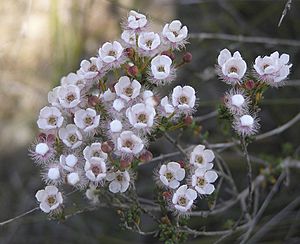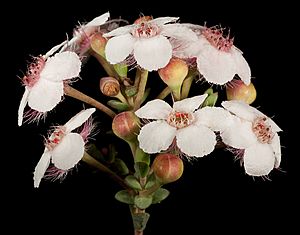Hidden featherflower facts for kids
Quick facts for kids Hidden featherflower |
|
|---|---|
 |
|
 |
|
| Scientific classification | |
| Genus: |
Verticordia
|
| Species: |
habrantha
|
| Synonyms | |
Verticordia habrantha, also known as hidden featherflower, is a type of flowering plant. It belongs to the myrtle family, called Myrtaceae. This plant only grows in the south-west part of Western Australia.
It is a thin bush with short, leafy branches and long stems that have round clusters of mostly white flowers. Its fuzzy outer flower parts (called sepals) are mostly hidden by its smooth, round petals. Because of this, the plant looks a bit like a waxflower, which is a close relative.
Contents
What it Looks Like
The hidden featherflower is a bush that usually grows to be about 15 to 90 centimeters (6 to 35 inches) tall and 10 to 50 centimeters (4 to 20 inches) wide. It has a few main stems with many short, leafy side branches.
- The leaves on the side branches are thin and shaped like a narrow oval. They are roughly triangular when you look at them from the end, and they are about 2 to 10 millimeters (0.08 to 0.4 inches) long.
- The leaves on the flowering stems are more oval or egg-shaped and can be up to 3 millimeters (0.12 inches) long.
The flowers grow in round clusters near the ends of the long flowering stems. Each flower sits on a straight stalk that is about 6 to 13 millimeters (0.2 to 0.5 inches) long. The base of the flower (called the floral cup) is about 1.5 millimeters (0.06 inches) long and covered with short, soft hairs.
The sepals are white, or sometimes light pink. They spread out but curve upwards and are about 3 to 4 millimeters (0.12 to 0.16 inches) long. They have 8 to 12 fuzzy parts and two ear-shaped, hairy appendages on the sides. The petals are the same color as the sepals and are egg-shaped to almost round, about 2.5 to 5 millimeters (0.1 to 0.2 inches) long. They spread out and have a smooth edge. The petals are joined with the ring of pollen-producing parts (called stamens) to form a short tube. The top part of the female reproductive organ (the style) is very short, less than 0.5 millimeters (0.02 inches) long, straight, and smooth.
This plant usually flowers from September to December.
The Verticordia group of plants is closely related to waxflowers. The hidden featherflower looks like a waxflower because its "feathery" sepals are hidden by its smooth petals.
How it Got its Name
The first official description of the hidden featherflower was written by Johannes Conrad Schauer in 1844. He described it in a book called Plantae Preissianae, using a plant sample collected by Ludwig Preiss near the Gordon River.
The second part of its scientific name, habrantha, comes from two ancient Greek words:
- habros means "dainty" or "pretty"
- anthos means "a flower"
So, its name means "pretty flower."
Where it Grows
This hidden featherflower usually grows in sandy soils. Sometimes the sand is on top of loam, clay, or gravel. It can also be found in gravelly soil that comes from granite. It often grows in areas that get flooded in winter. You can find it growing with other Verticordia plants in areas of heathland, shrubland, or woodland.
It is found in Western Australia, stretching from the Busselton area in the west to the Hamersley River in the east. It also grows north to Kulin and the Arthur River. These areas include several biogeographic regions like the Avon Wheatbelt, Esperance Plains, Jarrah Forest, Mallee, Swan Coastal Plain, and Warren.
Conservation Status
The Western Australian Government's Department of Parks and Wildlife says that Verticordia habrantha is "not threatened." This means it is not currently in danger of disappearing.
Growing it in Gardens
Even though this plant has attractive leaves and waxy-looking flowers, it has been hard to grow in gardens. Some types of the plant seem to be easier to grow than others. These hardier types have done well in areas that get rain in both summer and winter. People have tried to grow new plants from cuttings, but these have also been difficult to get started.
Images for kids
-
V. habrantha with other species, in a painting by Ellis Rowan


